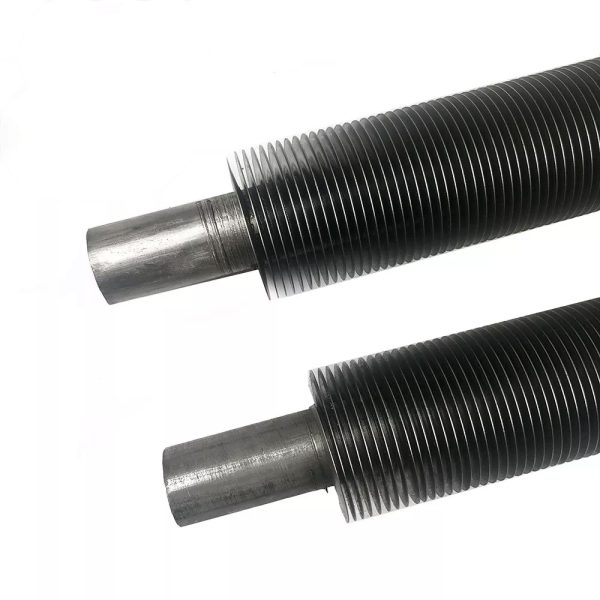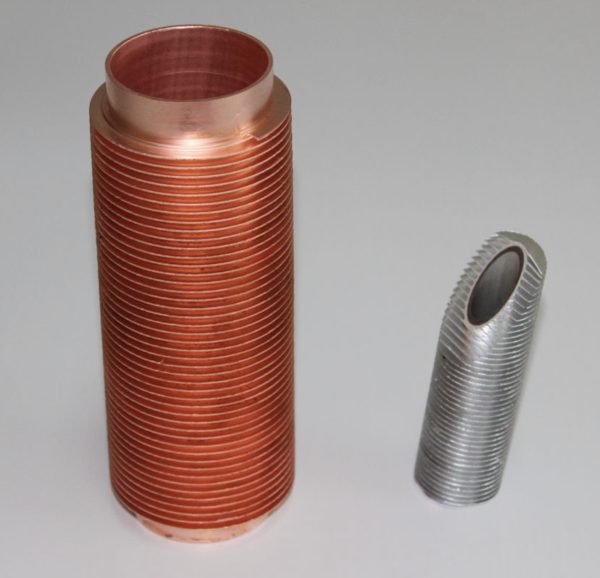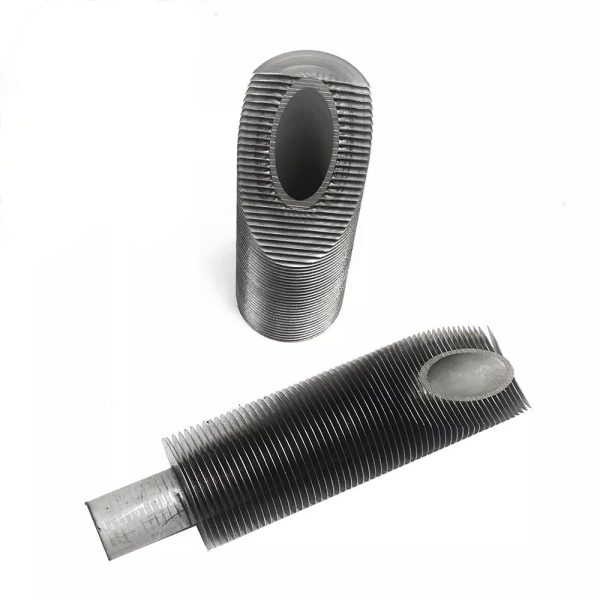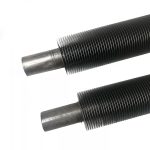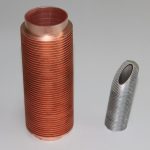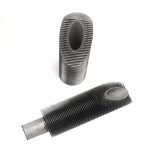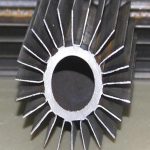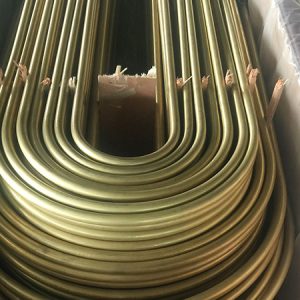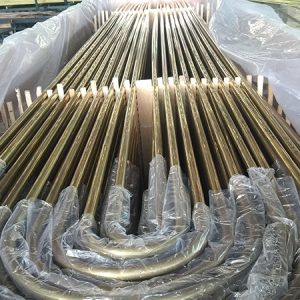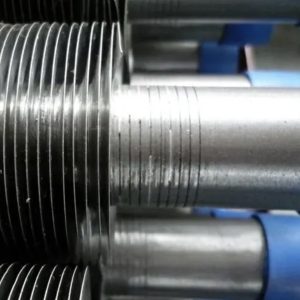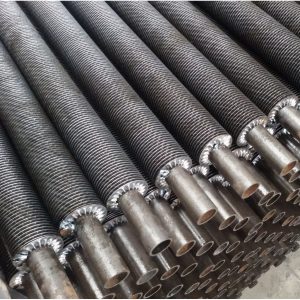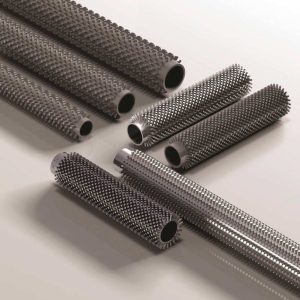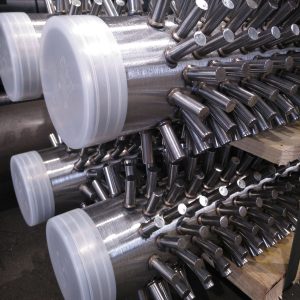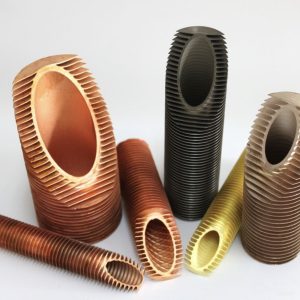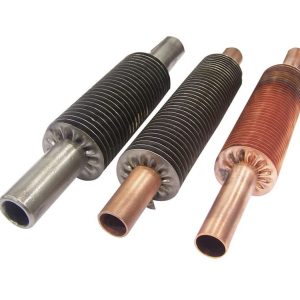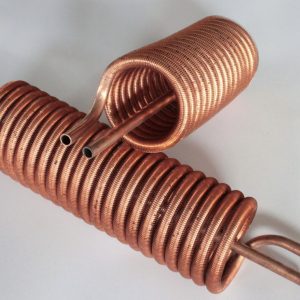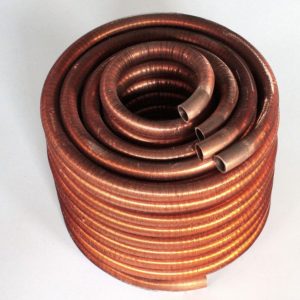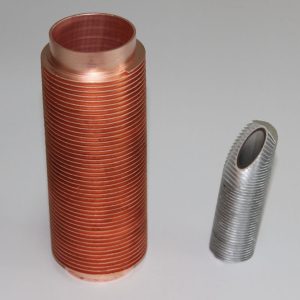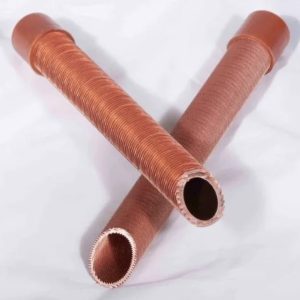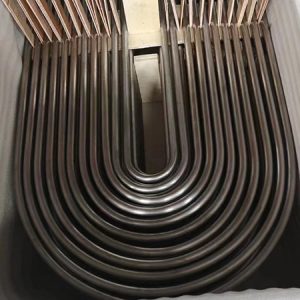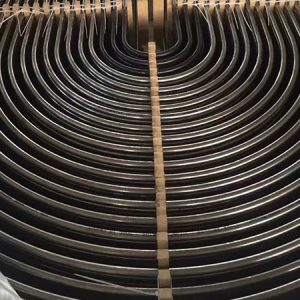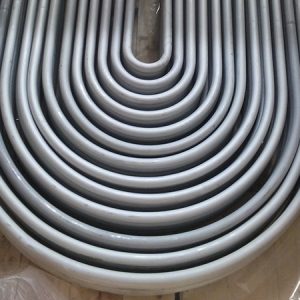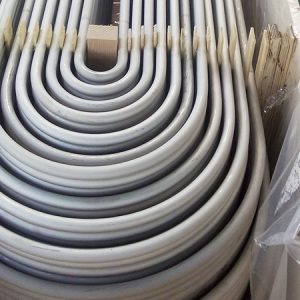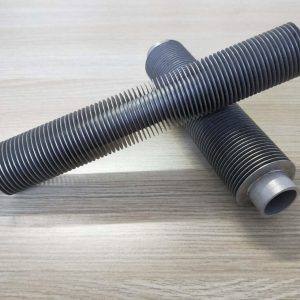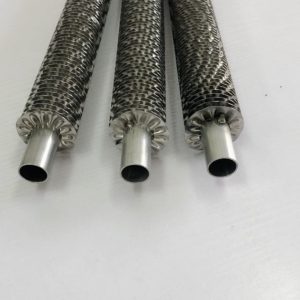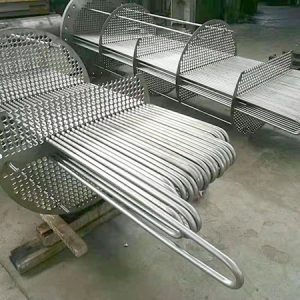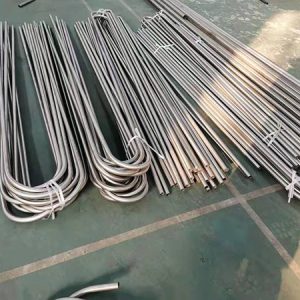Extruded Fin Tube
Extruded fin tube is rolled as an integrity with no thermal contact resistance, high intensity, featured in thermal shock and mechanical shock resistance. Heat exchangers assembled with this kind of fin tube (extruded fin type) is much better than the one equipped with string fin tubes or hectically wound fin tubes (L/LL/KL type fin).
Extruded Finned Tubes, also known as “Integral Finned Tubes”. Integral finned tubes are manufactured by rolling process on tubes. During finning operation, the inside diameter of the tubes is reduced and helical fins are rolled on the tube wall. The tubes material can be Copper Alloy, Brass Alloys, Copper Nickel Alloy, Titanium Alloy, Stainless Steel, Duplex Stainless Steel etc. The pressure required to extrude fins from the aluminum sleeve creates an excellent “pressure bond” between the two materials.
Copper and aluminum com-posited fin tubes are rolled from a muff copper tube, advantaged in tight link, small thermal resistance, good heat transfer efficiency, small flow loss and strong corrosion resistance. When working in long time under heating and cooling conditions, they are durable and not easy to deform.
The integral extruded fin tubes is smooth on surface and easy to clean. When wet cooling in heating and air conditioning project, it is easy to remove the condensation water on the outer surface of the fin, and it is not easy to dust and scale in the heating and other heat exchange.
- Description
- Inquiry
Description
Extruded Finned Tubes Product Range
Extruded Finned Tubes, also known as “Integral Finned Tubes”. Integral finned tubes are manufactured by rolling process on tubes. During finning operation, the inside diameter of the tubes is reduced and helical fins are rolled on the tube wall.
Integral Low Finned Tubes
- These have fin height less than or equal to fin pitch.
- Tube Length: Up to 32 meter.
- Outside Diameter OD: Between 9.52 mm and 38.10 mm.
- Tube Wall Thickness WT: 0.58 mm (min) and above.
- Fins per Inch: 11, 16, 19, 23, 26, 30, 40 and 52 FPI.
- Available in ferrous and nonferrous materials Copper Alloys, Copper-Nickel alloy, Admiralty Brass Alloy C44300, Aluminum Brass Alloy C68700, Carbon Steel.
Integral Medium High Finned Tubes
- Fin height more than fin pitch.
- Tube Length: Up to 32 meter.
- Outside Diameter: Between 19.05 mm and 31.75 mm.
- Tube wall thickness: 2.1 mm (min) and above.
- Fins per Inch: 11, 16 and 19 FPI.
- Available in ferrous and nonferrous materials.
Low Finned U Bend Tubes
- Manufactured on in-house finned tube bending facility.
- Easy to install in the equipment maintaining the circulation ratio.
- Absorb thermal shocks in heat exchanger.
- Available in Copper Alloys, Copper-Nickel alloy, Admiralty Brass Alloy C44300, Aluminum Brass Alloy C68700, Carbon Steel, 304 and 304L Stainless Steel ranging from 30R to 710R.
Low finned tubes with internal rib
- Externally enhanced surface area with integrally helical ribs on the inner side.
- Improved inside heat transfer coefficient.
- Available in Copper, Copper Nickel Alloy, Carbon Steel with externally 19, 26 fins per inch and internally 8, 10 Ribs.
Low Finned Tubes Coils
- Manufactured by coiling the integral finned tube.
- Improved heat transfer area therefore compact size of heat exchangers.
- Available in Copper, in coil diameters as per user’s requirement (Min Coil ID 50 mm).
High Finned Tubes
- High Finned Tubes have extruded fin heights up to 0.625″ (16mm). Single metal and bi-metallic finned tubes are available. Bi-metal finned tubes have a separate alloy liner tube inside the extruded fins. The mono-metal finned tubes have no liner tube with the fins integral with the tube.
Corrugated Tubes
- Manufactured by corrugation process of indenting plain tube with smooth and uniform spiral projections, which generate turbulence in both outside and inside media.
- Higher turbulence ensures uniform temperature distribution.
- No thinning of tube wall during process of corrugation.
Extruded Finned Tubes Characteristics
- Heat transfer per meter of tube on the outside is equal to the heat transfer per meter on the inside.
- The intermediate un-finned section and un-finned sections at both ends help to slip the integral finned tubes in to the tube-sheets of shell and tube heat exchanger in a manner similar to plain tubes.
Extruded Finned Tubes Benefits
- Combination of lower fin height and more fins per meter maintains the general ratio of 1:1 fin height to fin spacing.
- Doesn’t require higher tube pitch therefore, doesn’t require shell size higher than shell of bare tube heat exchanger.
- Improved heat transfer coefficient and rate of heat transfer as compared to conventional finned tube designs.
- Compact design of heat exchanger having lesser weight and size.
- Improved tube life.
Extruded Finned Tubes Quality Assurance
- Compliance with quality standards, ASME SB111, SB-359, SA-213, SA-450 and all codes as per ASME /EN/ JS.
- Customer / Third Party Inspection TPI.
- Fin dimensions checking by IMTEs and Profile checking on profile projector.
- Stress Relief Annealing of non-ferrous fin tube on in-house electric conveyor belt furnace.
- Stress relief annealing of ferrous fin tubes as per specifications provided if required by client at additional cost.
- 100% tubes tested for leakages by Hydrostatic Test as per standard and customers requirements.
- Third Party Inspection can be offered from Lloyd’s, BV, TUV, BHEL, NTPC, Intertek, SGS, EIL, IBR etc. as per customer requirement.
Extruded Finned Tubes Applications
- HVAC & Boiler
- Power Plants
- Heat Recovery Steam Generators
- Petrochemical Industries
- Marine Applications
- Refrigeration Applications
- Economizers
- Oil and Gas Coolers
- Plumbing and Air Conditioning
- Condensers and Evaporators
- Shell and Tube Heat Exchanger
- Other various Heat exchanger applications
Why use finned tubes?
Finned tubes are used in applications where high heat transfer rates are required, such as in power plants and refrigeration systems. The fins increase the surface area of the tube, allowing for more efficient heat transfer between two fluids. This makes them an ideal solution for heat transfer applications where space is limited.
Finned tubes are used in condensers, coolers, and furnaces. The larger surface area means that fewer tubes are needed compared to the use of plain tubes. This can decrease the overall equipment size and can in the long-run decrease the cost of the project.
Finned tube heat exchangers can be used in a broad range of industries including oil & gas, power generation, marine and HVAC&R. They generally use air to cool or heat fluids such as air, water, oil or gas, or they can be used to capture or recover waste heat.
The biggest problem with using a finned tube heat exchanger is with the cleaning and maintenance of the outer surface of the tubes. Because of the fins, mechanical cleaning becomes very difficult and you would have to go for chemical cleaning.
What is the difference between fin tube and finned tube?
Fin tubes are a type of heat exchanger that are used in many industries. They have a finned surface, which increases their surface area and allows them to transfer heat more efficiently. Finned tubes are typically used in two-phase heat transfer applications, such as condensation or evaporation.
Finned pipes are generally used for single-phase heat transfer applications. Both finned pipes and finned tubes use fins to increase the surface area for heat transfer.
Finned tubes are used when the heat transfer coefficient on the outside of the tubes is appreciably lower than that on the inside. They can reduce the equipment cost and also equipment sizes.
There are several kinds of fin tubes, such as:
- Extruded fin tube
- Crimped spiral fin tube
- G type embedded fin tube
- L/KL/LL Foot Fin Tube
What is the difference between high fin and low fin tubes?
High fin tubes are better for applications where the temperature difference between two fluids is high. Low fin tubes are better for applications where the temperature difference is low.
High fin tubes are made of a metal tube surrounded by an aluminum or copper strip. The strip can be applied in different ways, including type L, type KL, type LL, type G (embedded), or type extruded. The higher the fin height, the more surface area and heat transfer capabilities.
Low fin tubes are made of a single material and have a smaller fin of about 1/16th of an inch. They are generally used in liquid to liquid or liquid to gas applications such as coolers, condensers, and chillers.
The profile of the fins has a significant effect on the performance of a finned tube heat exchanger. The larger the fins and the tighter the fin pitch, the more thermal conductivity is achieved.
What is the role of finned tube in heat transfer?
Finned tubes are a series of tubes with fins on the outside. The fins increase the surface area for heat transfer, which increases the rate of heat exchange. Finned tubes are used in heat exchangers to transfer heat between hot and cold streams. The heat transfer rate depends on the temperature difference between the two fluids and the heat transfer coefficient between each of the fluids.
Finned tube heat exchangers are used in a variety of industries, including:
- Oil and gas
- Power generation
- Marine
- HVAC&R
Finned tube heat exchangers can be used to:
- Cool or heat fluids such as air, water, oil, or gas
- Capture or recover waste heat
- Finned tubes come in two types: transverse and longitudinal.
What is the heat transfer in tube and fins?
Heat transfer in tube and fins is a process that involves a fluid passing through tubes and conducting heat to fins. The fins then dissipate the heat to air that is blown over them. The fins increase the surface area for heat transfer, which increases the rate of heat exchange.
The amount of heat an object transfers is determined by the amount of conduction, convection, or radiation. The thermal flux is a function of both the thermal conductivity of solid parts and the convection heat coefficient between the gas and the surrounding walls. The shape and dimensions of the tubes and fins also affect the convection heat coefficient.
In an air-cooling fin-and-tube heat exchanger, heat transfers from the air flowing outside tubes to the liquid flowing inside the tubes. Because air has low thermal conductivity and density, it has poor heat transfer capability.

